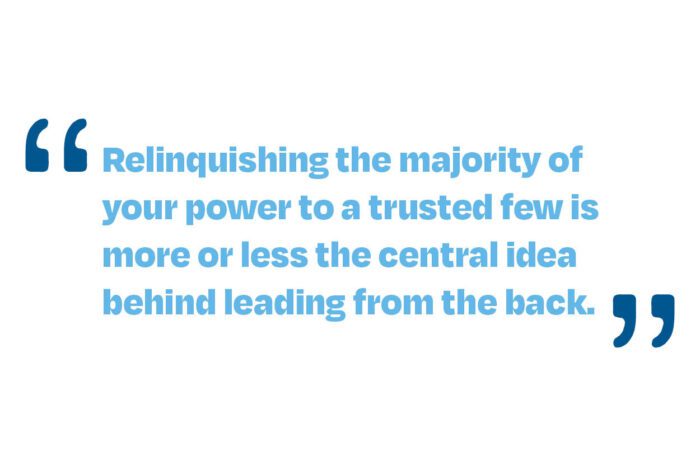In most classic business models, companies revolve around their leaders, placing them at the forefront of nearly all business ideas and ventures. We can’t necessarily fault this model because the word “lead” lends itself to the idea that the person in charge should be in front. A leader is an individual who leads the pack, guiding, directing, or instructing the people under them. However, just because this idea is popular and widely accepted, it doesn’t mean it’s what an effective leader does. So, we’ll tell you a secret: If you’re wondering how to be a true leader, lead from the back.

While we wish we could take credit for the idea of leading from behind, it was actually Nelson Mandela, the famous South African freedom fighter and the first black leader of South Africa, who coined the term.
In his 1994 autobiography, “Long Walk to Freedom,” Mandela reminisces about spending long days in open fields herding cattle when he was an 8-year-old boy. To direct the group, Mandela put the more clever and dominant cattle at the front of the herd while he walked behind to steer their direction using a long stick. He realized then that while the herd followed the more intelligent cattle he placed at the front, his use of the stick from behind ultimately determined where the cattle went. So while it may appear a shepherd simply follows the herd, allowing the more dominant cattle to dictate their direction, it’s actually the shepherd guiding the group with simple nudges from behind that enables them to avoid danger, make critical decisions, and achieve long-term success in the form of survival.
Mandela realized that he could apply this version of leadership to humans too.
But in modern management styles, this method deviates from the traditional form of CEOs and business owners leading their companies from the forefront. And we get it — leading from the front gives business owners more visibility, which makes them to believe they have more control of the business they worked so hard to develop. But sometimes, giving up that control makes a business owner more powerful.
Give Power To Get Power
In Mandela’s cattle herding example, he appears to have the least amount of power to an untrained eye. However, Mandela made one crucial decision that allowed his herding to succeed: He gave most of his leadership power to a few trusted cattle, which he placed at the front. This choice was not by coincidence, either. The more clever cattle were undoubtedly smart enough to guide the herd independently. But what made them the ideal options for Mandela to place them at the front was how in tune they were with the rest of the herd and their ability to take his direction and pivot.
Relinquishing the majority of your power to a trusted few is more or less the central idea behind leading from the back. In tough times, a business owner can step in and exercise their power from behind their staff just as a shepherd does, but for the most part, the system and management in place should be strong enough to govern itself.

So, what does this actually look like in the workplace?
If we follow this example as a company representing a herd of cattle and the business owner as the shepherd, it’s easy to imagine the general idea on paper. But, when looking practically, as in the actual day-to-day tasks of running a business, understanding how to be a true leader as the shepherd may not be as clear.
The easiest way is to identify the members of your team who can act as the more clever cattle did for Mandela. You want to encourage your team members who desire to inspire, lead, and grow your business to generate novel ideas that will ultimately take your company in new and exciting directions. And these directions can be something as simple as new marketing ideas, taking the lead on creating a fun work environment or trying new wellness initiatives.

Harvard business professor Linda Hill describes this as utilizing your team’s “collective genius,” and to do so, you must first encourage your team to generate new ideas. Then, you must give them the power to test these new ideas to take the company in those exciting new directions. If the ideas fall apart or don’t come to fruition, you simply use your “stick” to guide them back on course to try again.
Why Lead From The Back?
If your business isn’t using this model already, relinquishing most of your decision-making power to a select few can sound scary. More than scary, it can sound expensive, time-consuming, and risky.
So, why do it?
Team Members Want To Give More Input To Help Businesses Succeed.
According to Hill, that Harvard professor we mentioned earlier, “people are looking for more meaning and purpose in their work lives. They want and increasingly expect to be valued for who they are and to be able to contribute to something larger than themselves. People expect to have the opportunity to co-author their organization’s purpose. They want to be associated with organizations that serve as positive forces in the world.”
This untapped desire is a great way to get your team involved, motivated, and productive, but it also involves your team in decision-making processes that save your business time and money. Somewhere, in fact, to the tune of “half a million days of managers’ time, or $250 million a year in salaries,” according to one study.
But, aside from the front-end perks, a workforce involved in a company’s decision-making processes is more engaged with their work, generates better ideas, and is generally more healthy and has a lower mortality rate. Companies with engaged and healthy staff outperform those with unengaged teams by over 200%, earning more than 2.5 times the revenue too.

More Ideas, More Progress
When multiple people bring new ideas into a company’s framework, the company becomes more agile. This is because when problems arise, such as budgeting issues or even noticeable dips in consumer engagement, more people can contribute diverse ideas that may present better solutions than a single person with a top-down view.
Also, when a leader gives a team of individuals the power to generate new ideas, it promotes collaboration. A team that collaborates can turn a single idea into its best form, with all its kinks worked out and a plan to implement the idea to meet the needs of multiple people and departments. In research conducted by the Aberdeen Group, companies that emphasized cooperation and shared ideas saw “sales quota achievement of 82% (compared to 32% among those that did not participate).” This effort produced more ideas, more progress, and more profit too.
What Are Some Ways Business Owners Can Lead From The Back?
If you’re interested in how to be a true leader, as one that leads from behind rather than the front, there are a few simple changes anyone can implement to start the transition.
Share The Load
When business owners lead from the front, they often miss the struggles their team is experiencing behind them. When this happens, and a team is left to struggle through challenges on their own with no say, control, or guidance in how to proceed, trust and credibility between the team and the leader erode. When this treatment is habitual, the trust is nearly impossible to win back.
From behind the herd, a shepherd can know when the group needs a nudge with his stick. The same is true in the workplace, as a leader from behind can see obstacles like deadlines, criticism from shareholders, or shaky corporate contracts coming down the pipeline and gauge how the group reacts in real time. Then, the leader can provide the proper guidance, such as sharing the appropriate information with the team to address these issues. Doing so not only provides your decision-makers the ability to make better decisions, but it lets your team know you’re there for them, watching from behind for any possible threats to the company or their jobs. You haven’t barrelled on to the next big thing but are standing by to jump in when needed.
Recognize Hard Work And Show Gratitude
As much as you should step in to share the burdens of your team, you should step in to reward them too. If you know your staff has been working hard on the latest project they’ve taken on or have reached a new sales benchmark going above and beyond, let them know you saw and appreciate all the extra effort they’ve put in.

You don’t have to throw a party or pop a bottle of champagne every time someone closes a sale or jumps in to cover a shift, but a simple “thank you” or kind gesture can go a lot further than you’d think. Research by USC Marshall School of Business found that employees prefer handwritten thank-you notes or words of gratitude in one-on-one private meetings rather than in front of groups because they’re more sincere and require ample time and thought to create. This research also found that employees who are recognized and thanked are more engaged and happier with their work.
So, whether you write a thank-you note, pull someone aside for a private moment of sincerity, or pop bottles with the team, letting your staff know you see and appreciate their hard work only continues to drive engagement, productivity, confidence, and autonomy.

Begin With Small Power Shifts
While you may be unable to hand your company’s every decision over to your trusted team tomorrow, you can start small today. Starting small prepares you and your team — it allows you to acclimate to a decrease in control and your team to become accustomed to an increase in responsibility and autonomy.
Start by picking an area of your business you’d like to grow for the first time or an area that is more flexible with change, such as content creation or marketing strategies. Choose an unfamiliar project, such as launching an online store or new product, as it’s something entirely new that puts you on equal footing with your team and makes the transition a bit easier. Marketing strategies or content creation is fertile ground for experimentation, and audiences usually encourage and reward changes.

Once you’ve decided where organizational control can be shifted to your team, hold a meeting or workshop around that topic. This power shift doesn’t need to be a secret either: You can explain to your team your desire to give them more control and then use the workshop as a real-time shepherding experiment. Give them a topic to generate ideas about, and listen to what they say. If it’s difficult for them to take charge at first, use your hypothetical stick to nudge them in the right direction with different prompts or bits of information.
It may take a few workshops or meetings to get your team into the groove, but eventually, you can offload these small tasks onto them, and ultimately, more significant company decisions.
The transition from leading from the front to guiding your business from the back can feel counterintuitive at best. But when analyzing how to be a true leader, this switch ultimately sets successful companies apart from the ones that continually struggle with churn, toxic work environments, burnout, and compromised trust between leadership and employees.
At Newsletter Pro, leading from the back is a strategy we’ve used since the beginning, with each client’s team coming together to decide what’s best for each individual campaign. From project managers to writers, editors, and designers, every member has a say in the best way to create the ultimate newsletter.
So, if you want to learn more about our business journey and the practices that make Newsletter Pro successful, fill out the form below to request your free copy of our founder’s book, “The Ultimate Guide to Newsletters.”






